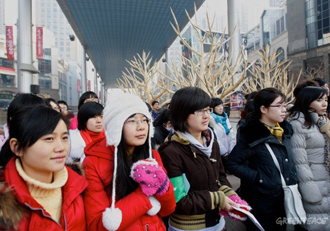China Consumers Remain Confident of Income Growth
By wchung | 26 Apr, 2025
Iron Shopping Bags: Spending habits suggest solid confidence of continuing good times among China's consumers.
China’s consumers are even more confident of continuing income growth this year than they were last year despite the high inflation rate, reported management consulting firm McKinsey & Co in its 2011 Annual Chinese Consumer Study in Shanghai.
Fifty-eight percent of survey respondents expect their income to increase next year, up from 39 percent in 2010.
The finding comes even as the rate of increase in real consumption has fallen from 9.4 percent in 2009 to 8.5 percent in 2010 and the CPI has risen from 4.6% in August 2010 to 6.2% in August of 2011, near the highest level in 3 years. The finding is a testament to the extraordinary sense of economic empowerment that China has instilled in the majority of its citizens with three decades of breakneck economic development.
This unshakeable confidence is sustaining a steady rise in consumer spending and changing buying habits. Not only did consumers increase spending over last year, they were inclined to buy more commodities, increase shopping frequency or buy more expensive goods. This contrasts with last year’s findings that consumers cut spending on some categories of commodities to balance spending in other areas.
Over a third (35%) say they are buying more expensive goods, up from 26% in 2010. Sixty percent are spending more to buy more commodities or to shop more frequently, compared with 54% last year. The maturing of China’s consumer market is suggested by the fact that only 5% increased spending by buying products for the first time, sharply down from 20% last year.
A decade ago most of the growth within product categories had come from first-time buyers. Now first-time buying makes up only a small percentage of spending. For example, in skin care and hair care only 3% who said they spent more were first-time buyers. First-time buying continues to be important for some big-ticket items or niche categories. For personal digital gadgets, 23% were first-time buyers.
Also, some geographical regions showed higher levels of first-time buying. In the Chengdu metropolitan area, for example, 15% said they had started to use certain personal care products only in the past year. The same products had only one percent first-time users in the more developed Hangzhou metropolitan area.
Brand names continued to loom large in consumer minds, mostly due to the perception that branded products ensure safety, higher quality or better reliability. However, this didn’t translate to loyalty to any particular brand. In fact, more consumers say they always choose from among brands and the number of brands they choose among continue to rise. The average Chinese consumer now chooses between three to five brands in any given category compared with two to three brands two years ago. There is even more brand option expansion in apparels where luxury brands are becoming increasingly popular.

China's consumers continue to show high confidence in continuing income growth in their spending habits.
Asian American Success Stories
- The 130 Most Inspiring Asian Americans of All Time
- 12 Most Brilliant Asian Americans
- Greatest Asian American War Heroes
- Asian American Digital Pioneers
- New Asian American Imagemakers
- Asian American Innovators
- The 20 Most Inspiring Asian Sports Stars
- 5 Most Daring Asian Americans
- Surprising Superstars
- TV’s Hottest Asians
- 100 Greatest Asian American Entrepreneurs
- Asian American Wonder Women
- Greatest Asian American Rags-to-Riches Stories
- Notable Asian American Professionals

